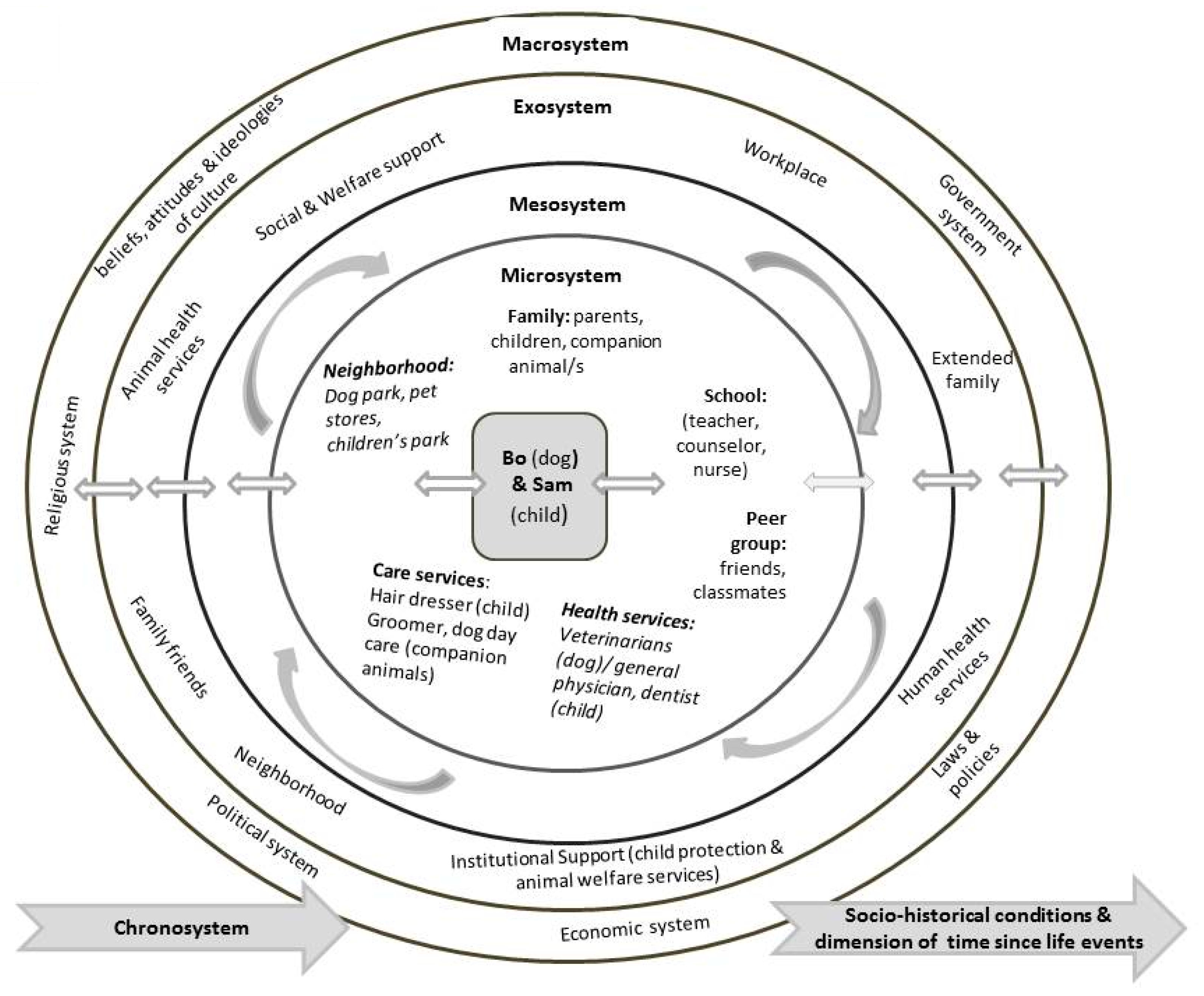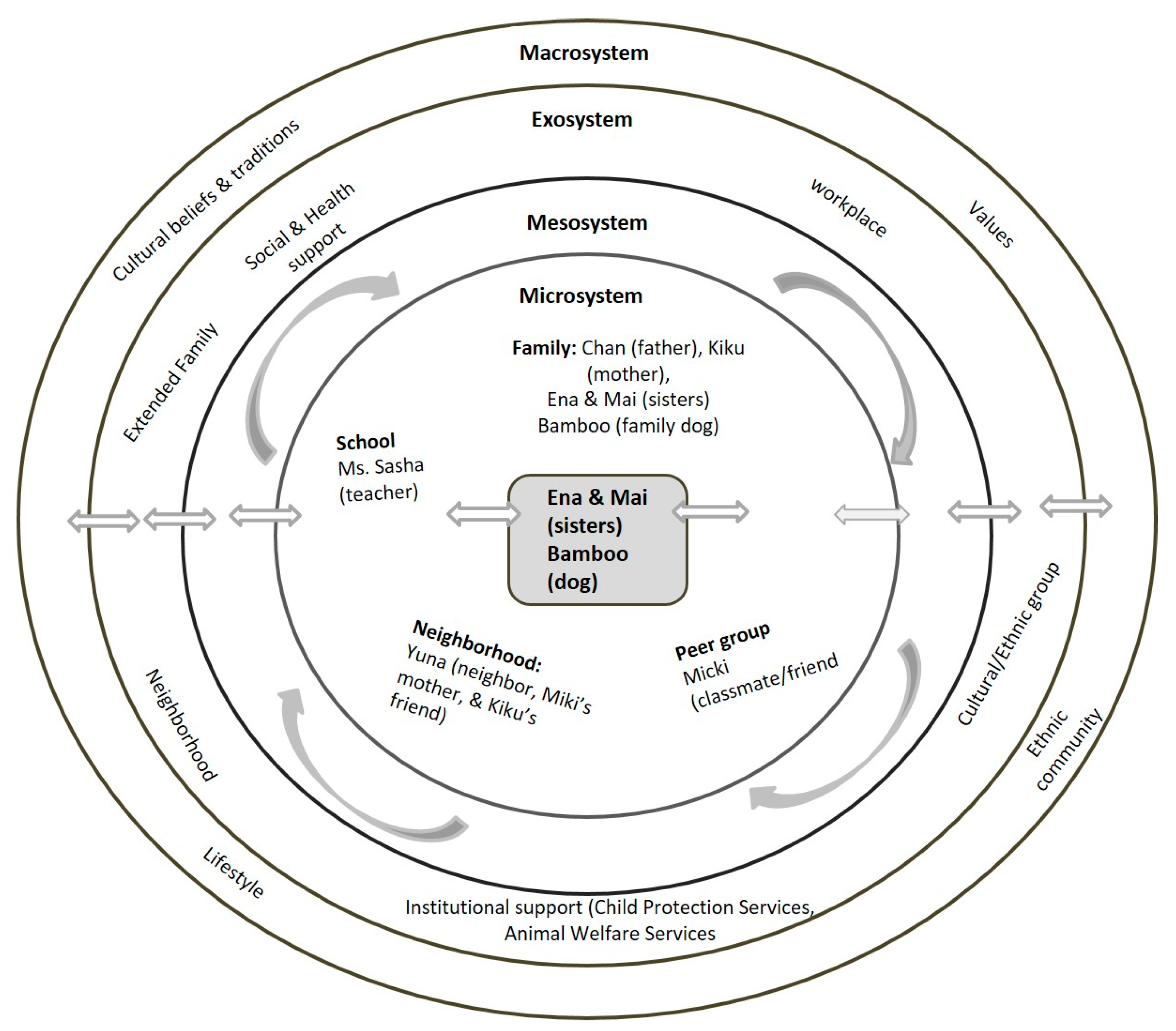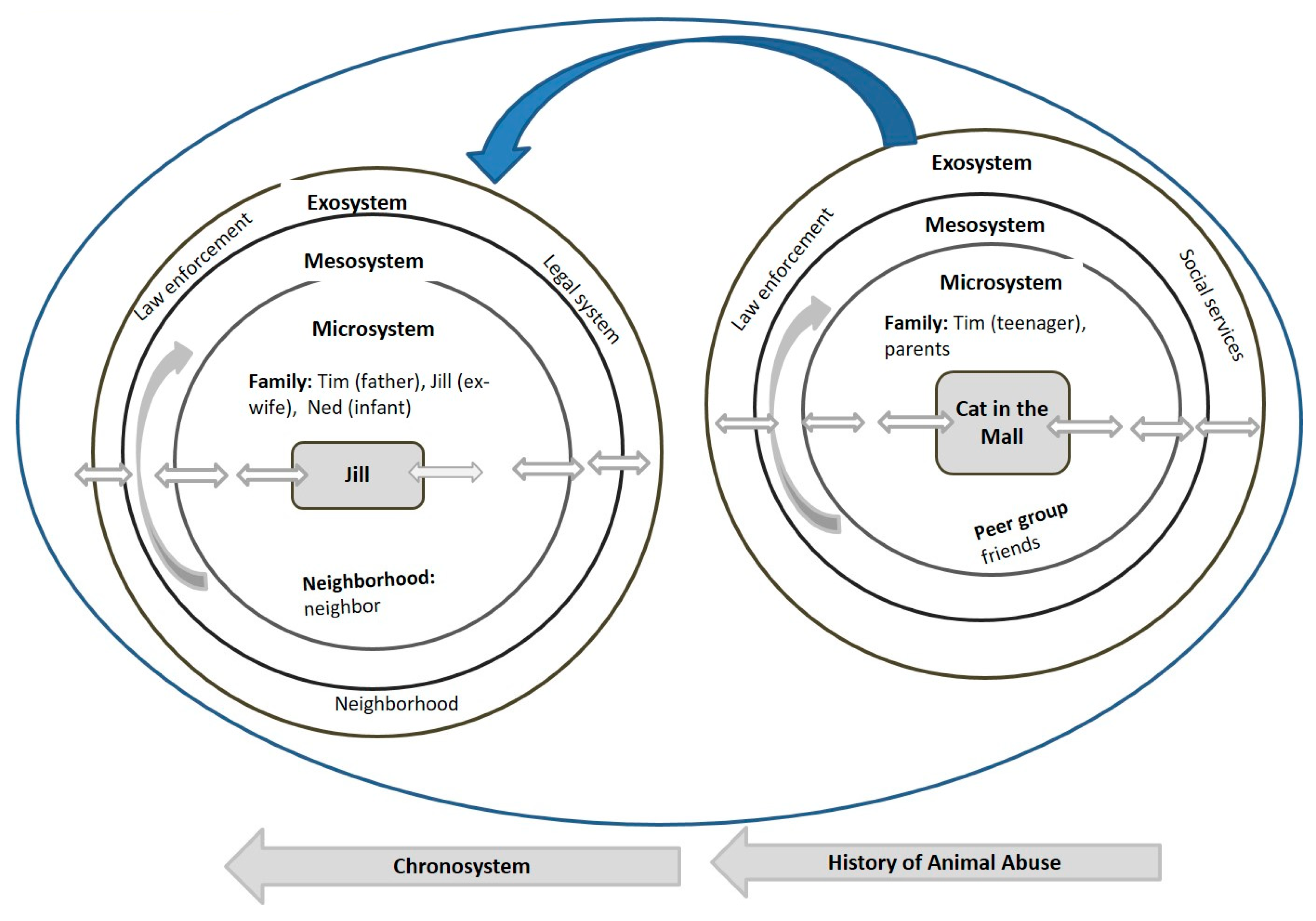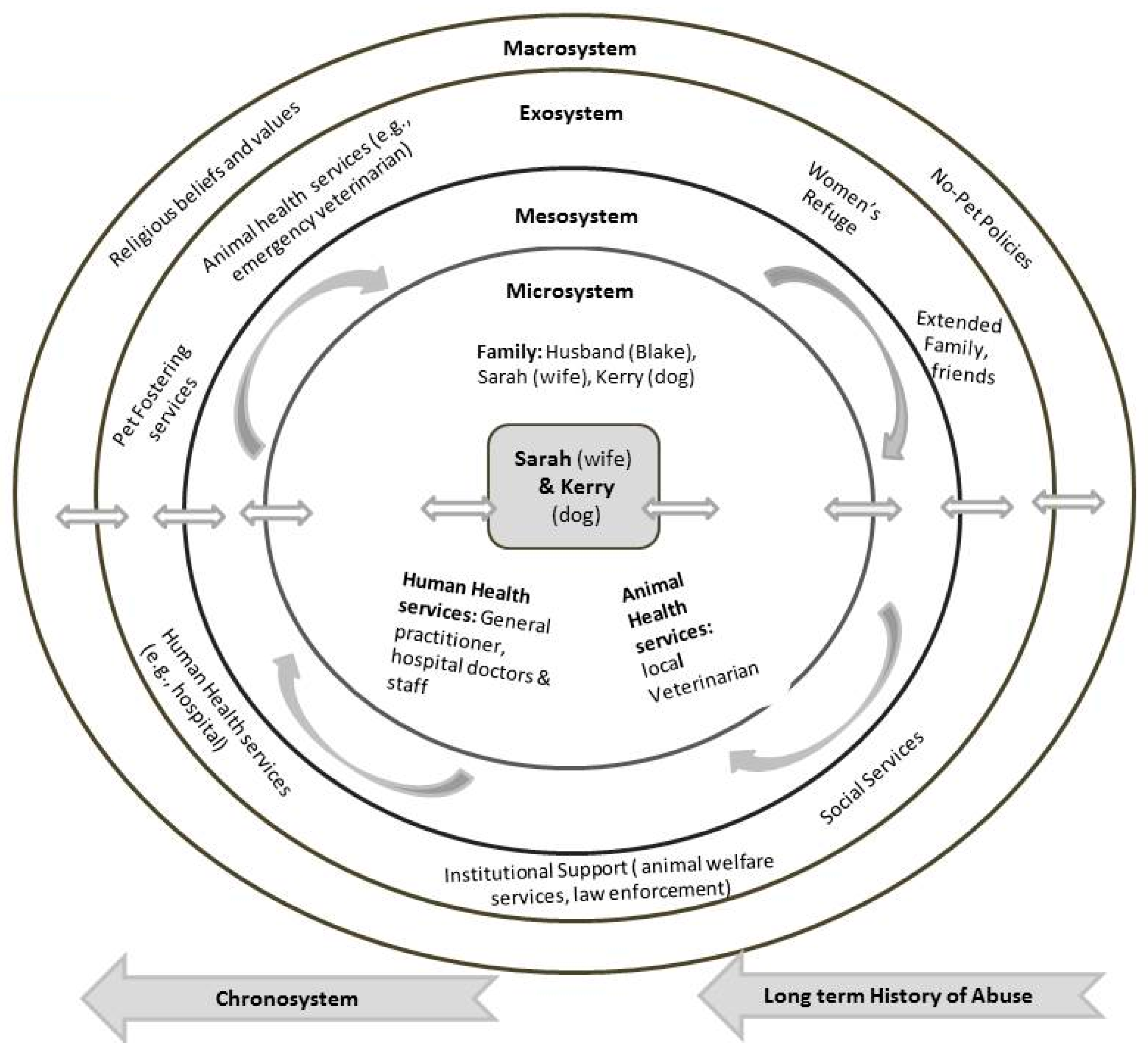Understanding the Link between Animal Cruelty and Family Violence: The Bioecological Systems Model
Abstract
1. Introduction
1.1. Companion Animals in the Family System
1.2. One Health-One Welfare
1.3. The Link—Animal Cruelty and Family Violence
1.3.1. Animal Cruelty as a Marker
1.3.2. Impact of Witnessing Animal Cruelty
1.4. Bronfenbrenner’s Bioecological Systems Model
1.5. Animal Abuse and Family Violence: Integrating the Bioecological Systems Model
1.6. Transdisciplinary Collaboration: An Approach for the Identification and Prevention of Violence and Protection of Animal and Human Victims
2. Methodology
Ethical Issues
3. The Link between Child Abuse, Animal Abuse, and Family Violence: Four Cases of Connections
3.1. Case 1 Synopsis: The Abuse of Sisters Ena and Mai and Their Dog Bamboo (USA)
3.1.1. Case 1: Contextual Information
3.1.2. Case 1: Analysis Using the Bioecological Systems Theory
3.2. Case 2 Synopsis: The Killing of an Infant in a Family (UK)
3.2.1. Case 2: Contextual Information
3.2.2. Case 2: Analysis Using the Bioecological Systems Theory
3.3. Case 3 Synopsis: A Lack of Timely Intervention in a Troubled Youth Who Brutally Killed a Kitten and Continued Violence a Decade Later (The Netherlands)
3.3.1. Case 3: Contextual Information
3.3.2. Case 3: Analysis Using the Bioecological Systems Theory
3.4. Case 4 Synopsis: Woman and Dog, Who Had Both Been Subjected to Years of Abuse, Rescued by a Veterinarian and Her Transdisciplinary Team (UK)
3.4.1. Case 4: Contextual Information
3.4.2. Case 4: Analysis Using the Bioecological Systems Theory
4. Conclusions
Author Contributions
Funding
Acknowledgments
Conflicts of Interest
References
- American Pet Products Association 2019–2020. Available online: https://www.americanpetproducts.org/pubs_survey.asp (accessed on 16 April 2020).
- Report Feiten en Cijfers Gezelschapdierensector 2015. Available online: https://www.rijksoverheid.nl/documenten/rapporten/2015/11/03/feiten-cijfers-gezelschapsdierensector-2015 (accessed on 16 April 2020).
- Notre Planet. Available online: https://www.notre-planete.info/actualites/3751-nombre-animaux-compagnie-France (accessed on 16 April 2020).
- Pet Food Manufacturers Association Annual Report 2019. Available online: https://www.pfma.org.uk/_assets/docs/annual-reports/PFMA-2019-Annual-Report.pdf (accessed on 16 April 2020).
- McNicolas, J.; Gilbey, A.; Rennie, A.; Ahmedzai, S.H.; Dono, J.A.; Ormerod, E. Pet ownership and human health: A brief review of evidence and issues. Br. Med. J. 2005, 331, 1252–1254. [Google Scholar] [CrossRef] [PubMed]
- Podberscek, A.; Serpell, J. Companion Animals and Us; Cambridge University Press: Cambridge, UK, 2000. [Google Scholar]
- Geerdts, M. (Un)Real animals: Anthropomorphism and early learning about animals. Child Dev. Perspect. 2015, 10, 10–14. [Google Scholar] [CrossRef]
- Jegatheesan, B. The give and take in the Human-Animal Bond: Three tales of spirit healing. Reflect. Narrat. Prof. Health 2009, 15, 6–14. [Google Scholar]
- Jegatheesan, B.; Meadan, H. Pets in the Classroom: Promoting and Enhancing the Socio-Emotional Wellness of Young Children. Young Except. Child. Monogr. 2010, 8, 1–12. [Google Scholar]
- McNicolas, J.; Collis, G.M. Children’s representations of pets in their social networks. Child Care Health Dev. 2001, 27, 279–294. [Google Scholar] [CrossRef] [PubMed]
- Melson, G.; Peet, S.; Sparks, C. Children’s attachment to their pets: Links to socio-emotional development. Child. Environ. Q. 1991, 8, 55–65. [Google Scholar]
- Melson, G. Child development and the human companion animal bond. Am. Behav. Sci. 2003, 47, 31–39. [Google Scholar] [CrossRef]
- Levinson, B. Pet-Orientated Child Psychotherapy, 2nd ed.; Mallon, G., Ed.; Charles C. Thomas Publisher: Springfield, IL, USA, 1997. [Google Scholar]
- McConnel, A.R.; Brown, C.; Martin, C.E. Friends with benefits: On the positive consequences of pet ownership. J. Personal. Soc. Psychol. 2011, 101, 1239–1252. [Google Scholar] [CrossRef]
- DeGue, S.; DiLillo, D. Is animal cruelty a “red flag” for family violence? Investigating co-occurring violence toward children, partners, and pets. J. Interpers. Violence 2009, 24, 1036–1056. [Google Scholar] [CrossRef]
- Richard, L.; Gauvin, L.; Raine, K. Ecological models revisited. Their uses and evolution in health promotion over two decades. Annu. Rev. Public Health 2011, 32, 307–326. [Google Scholar] [CrossRef]
- Garnier, W.; Enders-Slegers, M.J. Huiselijk Geweld en Dierenmishandeling in Nederland. Een Verkennend Onderzoek naar de Relatie Tussen Huiselijk Geweld en Dierenmishandeling onder Vrouwelijke Slachtoffers van Huiselijk Geweld; NB the Number 44 Is in Italics; Kadera, Aanpak Huiselijk Geweld: Zwolle, The Netherlands, 2012. [Google Scholar]
- Jegatheesan, B. Muslim American children’s views on animal wellness and ethics. In Proceedings of the International Association of Human-Animal Interaction Organizations (IAHAIO) Conference, Chicago, IL, USA, 22 July 2013. [Google Scholar]
- Ormerod, E.J. Bond-centered veterinary practice: Lessons for veterinary faculty and students. J. Vet. Med. Educ. 2008, 35, 545–551. [Google Scholar] [CrossRef] [PubMed]
- Boyden, P.; (Dogs Trust, London, UK); Jegatheesan, B.; (University of Washington, Seattle, WA, USA). Personal communication, 2018.
- Ascione, F.R.; Weber, C.V.; Thompson, T.M.; Heath, J.; Maruyama, M.; Hayashi, K. Battered pets and domestic violence: Animal abuse reported by women experiencing intimate violence and by nonabused women. Violence Against Women 2007, 13, 354–373. [Google Scholar] [CrossRef] [PubMed]
- Baldry, A.C. Animal abuse and exposure to interparental violence in Italian youth. J. Interpers. Violence 2003, 18, 258–281. [Google Scholar] [CrossRef]
- McIntosh, S.C. The Links between Animal Abuse and Family Violence, as Reported by Women Entering Shelters in Calgary Communities; Canadian Veterinary Medical Association: Ottawa, ON, Canada, 2004; Available online: https://www.canadianveterinarians.net/uploads/userfiles/files/mcintoshcalgarystudy.pdf (accessed on 10 April 2020).
- Jury, A.; Thorburn, N.; Bury, K.; National Collective of Independent Women’s Refuges. Pet Abuse as Part of Intimate Partner Violence. 2018. Available online: https://womensrefuge.org.nz/wp-content/uploads/2019/11/Pet-Abuse-Report-.pdf (accessed on 16 April 2020).
- WSAVA One Health Committee Report 2012. Available online: https://www.vin.com/apputil/content/defaultadv1.aspx?pId=11349&id=5328347 (accessed on 17 April 2020).
- Jordan, T.; Lem, M. One Health, One Welfare: Education in practice. Veterinary students’ experiences with community veterinary outreach. Can. Vet. J. 2014, 55, 1203–1206. [Google Scholar]
- The Centers for Disease Control and Prevention (CDC). One Health. Available online: https://www.cdc.gov/onehealth/index/html (accessed on 18 April 2020).
- Frasier, D. Assessing animal welfare: Different philosophies, different scientific approaches. Zoo Biol. 2009, 28, 507–518. [Google Scholar] [CrossRef]
- Pinillos, R.G.; Appleby, M.; Manteca, X.; Scott-Park, F.; Smith, C.; Velarde, A. One Welfare—A platform for improving human and animal welfare. Vet. Rec. 2016, 22, 412–413. [Google Scholar]
- Newberry, M. Pets in danger: Exploring the link between domestic violence and animal abuse. Aggress. Violent Behav. 2017, 34, 273–281. [Google Scholar] [CrossRef]
- Ascione, F.R. Children Who Are Cruel to Animals: A Review of Research and Implications for Developmental Psychopathology. Anthrozoos 1993, 6, 226–247. [Google Scholar] [CrossRef]
- Ascione, F.R.; Thompson, T.M.; Black, T. Childhood cruelty to animals: Assessing cruelty dimensions and motivations. Anthrozoos 1997, 10, 170–177. [Google Scholar] [CrossRef]
- McPhedran, S. Animal abuse, family violence, and child wellbeing: A review. J. Fam. Violence 2009, 24, 41–52. [Google Scholar] [CrossRef]
- Vermeulen, H.; Odendaal, J.S.J. Proposed typology of companion animal abuse. Anthrozoos A Multidiscip J. Interact. People Anim. 1993, 6, 248–257. [Google Scholar]
- Connor, M.; Currie, C.; Lawrence, A.B. Factors influencing the prevalence of animal cruelty during adolescence. J. Interpers. Violence 2018, 1–24. [Google Scholar] [CrossRef]
- Gullone, E. Conceptualizing animal abuse with an antisocial behavior of framework. Animals 2011, 1, 144–160. [Google Scholar] [CrossRef]
- Arluke, A.; Levin, J.; Luke, C.; Ascione, F. The relationship of animal abuse to violence and other forms of antisocial behavior. J. Interpers. Violence 1999, 14, 963–975. [Google Scholar] [CrossRef]
- Ascione, F.R. The abuse of animals and human interpersonal violence: Making the connection. In Child Abuse, Domestic Violence, and Animal Abuse: Linking the Circles of Compassion for Prevention and Intervention; Ascione, F.R., Arkow, P., Eds.; Purdue University Press: West Lafayette, IN, USA, 1999; pp. 50–61. [Google Scholar]
- Ascione, F.R.; Weber, C.V.; Wood, D.S. Animal Welfare and Domestic Violence Report Submitted to the Geraldine Dodge Foundation, April 1997. Available online: http://www.vachss.com/guest_dispatches/ascione_2.html (accessed on 12 April 2020).
- Barrett, B.J.; Fitzgerald, A.; Stevenson, R.; Cheung, C.H. Animal Maltreatment as a Risk Marker of More Frequent and Severe Forms of Intimate Partner Violence. J. Interpers. Violence 2017, 24, 1036–1056. [Google Scholar] [CrossRef]
- Becker, F.; French, L. Making the links: Child abuse, animal cruelty and domestic violence. Child Abus. Rev. 2004, 13, 399–414. [Google Scholar] [CrossRef]
- Boat, B.W. Commentary: The relationship between violence to children and violence to animals. J. Interpers. Violence 1995, 10, 229–235. [Google Scholar] [CrossRef]
- Flynn, C.P. Examining the links between animal abuse and human violence. Crime Law Soc. Chang. 2011, 55, 453–468. [Google Scholar] [CrossRef]
- Flynn, C.P. Why Family Professionals Can No Longer Ignore Violence toward Animals. Fam. Relat. 2000, 49, 87–95. [Google Scholar] [CrossRef]
- Flynn, C.P. Woman’s best friend: Pet abuse and the role of companion animals in the lives of battered women. Violence Against Women 2000, 6, 162–177. [Google Scholar] [CrossRef]
- Regan, T.; Singer, P. (Eds.) Animal Rights and Human Obligations; Prentice-Hall: Upper Saddle River, NJ, USA, 1976. [Google Scholar]
- Kempe, C.H.; Silverman, F.N.; Steele, B.F.; Droegemueller, W.; Silver, H.K. The battered child syndrome. J. Am. Med. Assoc. 1962, 181, 17–24. [Google Scholar] [CrossRef] [PubMed]
- Mead, M. Cultural factors in the cause and prevention of pathological homicide. Bull. Menn. Clin. 1964, 28, 11–22. [Google Scholar]
- American Psychiatric Association. Diagnostic and Statistical Manual of Mental Disorders, 3rd ed.; American Psychiatric Association: Washington, DC, USA, 1987. [Google Scholar]
- American Psychiatric Association. Diagnostic and Statistical Manual of Mental Disorders, 5th ed.; American Psychiatric Association: Washington, DC, USA, 2013. [Google Scholar]
- McDonald, J.M. The threat to kill. Am. J. Psychiatry 1963, 120, 125–130. [Google Scholar] [CrossRef]
- Hellman, D.S.; Blackman, N. Enuresis, firesetting and crFuelty to animals: A triad predictive of adult crime. Am. J. Psychiatry 1966, 122, 1431–1435. [Google Scholar] [CrossRef]
- Fucini, S. The abuser: First a dog then a child? Am. Hum. 1978, 5, 14–15. [Google Scholar]
- Van Leeuwen, J. A child psychiatrist’s perspective on children and their companion animals. In Interrelations between People and Pets; Fogle, B., Ed.; Thomas: Springfield, IL, USA, 1987; pp. 175–194. [Google Scholar]
- Hutton, J.S. Animal abuse as a diagnostic approach in social work: A pilot study. In Proceedings of the International Conference on the Human-Companion Animal Bond, Philadelphia, PA, USA, 5–7 October 1981. [Google Scholar]
- De Viney, E.; Dickert, J.; Lockwood, R. The Care of Pets within Child Abusing Families. Int. J. Study Anim. Probl. 1983, 4, 321–329. [Google Scholar]
- Kellert, S.R.; Felthous, A.R. Childhood cruelty toward animals among criminals and non-criminals. Hum. Relat. 1985, 38, 1113–1129. [Google Scholar] [CrossRef]
- Ascione, F.R. Battered women’s reports of their partners’ and their children’s cruelty to animals. J. Emot. Abus. 1998, 1, 119–133. [Google Scholar] [CrossRef]
- Krienert, J.L.; Walsh, J.A.; Matthews, K.; McConkey, K. Examining the nexus between domestic violence and animal abuse in a national sample of service providers. Violence Vict. 2012, 27, 280–295. [Google Scholar] [CrossRef]
- Volant, A.M.; Johnson, J.A.; Gullone, E.; Coleman, G.J. The Relationship between Domestic Violence and Animal Abuse: An Australian Study. J. Interpers. Violence 2008, 23, 1277–1295. [Google Scholar] [CrossRef]
- Ascione, F.R. Men in Prison Who Abused Animals and Who Abused Their Wives and Girlfriends: Voices of Perpetrators. In Proceedings of the 11th International Conference on Human-Animal Interactions, People & Animals: Partnership in Harmony (IAHAIO), Tokyo, Japan, 5–8 October 2007. [Google Scholar]
- Bright, M.A.; Huq, M.S.; Spencer, T.; Applebaum, J.W.; Hardt, N. Animal cruelty as an indicator of family trauma: Using adverse childhood experiences to look beyond child abuse and domestic violence. Child Abuse Negl. 2018, 76, 287–296. [Google Scholar] [CrossRef] [PubMed]
- Simmons, C.; Lehmann, P. Exploring the link between pet abuse and controlling behaviors in violent relationships. J. Interpers. Violence 2007, 22, 1211–1222. [Google Scholar] [CrossRef] [PubMed]
- Faver, C.; Cavazos, A. Animal abuse and domestic violence. A view from the border. J. Emot. Abus. 2007, 7, 59–81. [Google Scholar] [CrossRef]
- Appel, A.E.; Holden, G.W. The co-occurrence of spouse and physical child abuse: A review and appraisal. J. Fam. Psychol. 1998, 12, 578–599. [Google Scholar] [CrossRef]
- Campbell, A.M.; Thompson, S.L.; Harris, T.L.; Wiehe, S.E. Intimate partner violence and pet abuse: Responding law enforcement officers’ observations and victim reports from the scene. J. Interpers. Violence 2018, 1–20. [Google Scholar] [CrossRef] [PubMed]
- Roguski, M. Pets as Pawns: The Co-Existence of Animal Cruelty and Family Violence. Report for Royal New Zealand Society for the Prevention of Cruelty to Animals and the National Collective of Independent Women’s Refuges. 2012. Available online: http://nationallinkcoalition.org/wp-content/uploads/2013/01/DV-PetsAsPawnsNZ.pdf (accessed on 12 April 2020).
- Edleson, J.L. Children’s witnessing of adult domestic violence. J. Interpers. Violence 1999, 14, 839–870. [Google Scholar] [CrossRef]
- Margolin, G. Children’s exposure to violence: Exploring developmental pathways to diverse outcomes. J. Interpers. Violence 2005, 20, 72–81. [Google Scholar] [CrossRef]
- Currie, C.L. Animal cruelty by children exposed to domestic violence. Child Abus. Negl. 2006, 30, 425–435. [Google Scholar] [CrossRef]
- Thompson, K.L.; Gullone, E. An investigation into the association between the witnessing of animal abuse and adolescents’ behavior towards animals. Soc. Anim. 2006, 14, 221–224. [Google Scholar] [CrossRef]
- Kolko, J.R.; Blakely, E.H.; Engelman, D. Children who witness domestic violence: A review of the empirical literature. J. Interpers. Violence 1996, 11, 281–293. [Google Scholar]
- Parkes, D.; Signal, T. Revisiting a link: Animal abuse, bullying, and empathy in Australian youth. Hum. Anim. Interact. Bull. 2017, 5, 26–40. [Google Scholar]
- Walters, G. Animal cruelty and bullying: Behavioral markers of delinquency risk, or causal antecedents of delinquent behavior? Int. J. Law Psychiatry 2019, 62, 77–84. [Google Scholar] [CrossRef] [PubMed]
- McDonald, S.E.; Collins, E.A.; Nicotera, N.; Hageman, T.O.; Ascione, F.R.; Williams, J.H.; Graham-Bermann, S.A. Children’s experiences of companion animal maltreatment in households characterized by intimate partner violence. Child Abus. Negl. 2015, 50, 116–127. [Google Scholar] [CrossRef]
- Arkow, P. Breaking the Cycles of Violence: A Practical Guide; Latham Foundation: Alameda, CA, USA, 1995. [Google Scholar]
- Faver, C.A.; Strand, E.B. To leave or to stay?: Battered women’s concern for vulnerable pets. J. Interpers. Violence 2003, 18, 1267–1377. [Google Scholar] [CrossRef]
- Dogs Trust Freedom Project. Available online: https://www.dogstrust.org.uk/help-advice/hope-project-freedom-project/ (accessed on 16 April 2020).
- Stay Away from My Animal. Available online: https://www.blijfvanmijndier.nl (accessed on 16 April 2020).
- The Orange House. Available online: https://www.blijfgroep.nl (accessed on 16 April 2020).
- Bronfenbrenner, U. Social ecology of human development. In Brain and Intelligence: The Ecology of Child Development; Richardson, F., Ed.; National Education Press: Hyattsville, MD, USA, 1973; pp. 113–129. [Google Scholar]
- Bronfenbrenner, U. Developmental research, public policy, and the ecology of childhood. Child Dev. 1974, 45, 1–5. [Google Scholar] [CrossRef]
- Bronfenbrenner, U. Reality and research in the ecology of human development. Proc. Am. Philos. Soc. 1975, 119, 439–469. [Google Scholar]
- Bronfenbrenner, U. Toward an experimental ecology of human development. Am. Psychol. 1977, 32, 513–531. [Google Scholar] [CrossRef]
- Bronfenbrenner, U. The Ecology of Human Development; Harvard University Press: Cambridge, MA, USA, 1979. [Google Scholar]
- Bronfenbrenner, U. Interacting systems in human development. Research paradigms: Present and future. In Persons in Context: Developmental Processes; Bolger, N., Capsi, A., Downy, G., Moorehouse, M., Eds.; Cambridge University Press: Cambridge, UK, 1988; pp. 25–49. [Google Scholar]
- Bronfenbrenner, U. Ecological models of human development. In International Encyclopedia of Education, 2nd ed.; Elsevier: Amsterdam, The Netherlands, 1994; Volume 3. [Google Scholar]
- Bronfenbrenner, U. Environments in developmental perspective: Theoretical and operational models. In Measuring Environment across the Life Span: Emerging Methods and Concepts; Freidman, S.L., Wachs, T.D., Eds.; American Psychological Association: Washington, DC, USA, 1999; pp. 3–28. [Google Scholar]
- Bronfenbrenner, U.; Morris, P.A. The bioecological model of human development. In Handbook of Child Psychology; Theoretical Models of Human Development; Damon, W., Lerner, R.M., Eds.; Wiley: New York, NY, USA, 2006; Volume 1, pp. 793–828. [Google Scholar]
- Ormerod, E. Animal-assisted Interventions: Animal welfare and the role of the veterinarian. In Proceedings of the American Veterinary Medical Association (AVMA) Congress, International Association of Human-Animal Interaction Organizations (IAHAIO) Conference, Chicago, IL, USA, 22 July 2013. [Google Scholar]
- American Psychiatric Association. Diagnostic and Statistical Manual of Mental Disorders, 4th ed.; American Psychiatric Association: Washington, DC, USA, 1994. [Google Scholar]
- Lockwood, R. Making the connection between animal cruelty and abuse and neglect of vulnerable adults. Latham Lett. 2002, VXX111, 10–11. [Google Scholar]
- Enders-Slegers, M.J.; Janssen, M.A. Cirkel van geWeld. Verbanden Tussen Dierenmishandeling en Huiselijk Geweld; Stichting Dierzijn: Amsterdam, The Netherlands, 2009. [Google Scholar]
- Enders-Slegers, M.J.; Verheggen, T.; Jannes, E. Awareness can change a society: The Link between animal abuse and domestic violence in The Netherlands. In Companion Animals in Everyday Life; Pregowski, M., Ed.; Palgrave Macmillan: London, UK, 2009. [Google Scholar]
- Norden, N. Experience in Sweden Making the LINK. In One Health, One Welfare: The Importance of Research, Education and Cooperation; Tallinn University: Tallinn, Estonia, 2018. [Google Scholar]
- Bruner, C. Ten Questions and Answers to Help Policy Makers Improve Children’s Services; Education and Human Services Consortium: Washington, DC, USA, 1991. [Google Scholar]
- Berg-Weger, M.; Schneider, F.D. Interdisciplinary collaboration in social work education. J. Soc. Work Educ. 1998, 34, 97–107. [Google Scholar] [CrossRef]
- Mattessich, P.; Monsey, B. Collaboration: What Makes It Work, 5th ed.; Amherst, M., Ed.; Wilder Foundation: St. Paul, MN, USA, 1992. [Google Scholar]
- Soler, M.; Shauffer, C. Fighting fragmentation: Coordination of services for children and families. Educ. Urban Soc. 1993, 25, 129–140. [Google Scholar] [CrossRef]
- Abraham, A. Isolation as a form of marital violence: The South Asian immigrant experience. J. Soc. Distress Homeless 2000, 9, 221–236. [Google Scholar] [CrossRef]
- Fagan, J.A.; Browne, A. Violence between spouses and intimates: Physical aggression between women and men in intimate relationships. In Understanding and Preventing Violence; Reiss, A.J., Jr., Roths, J.A., Eds.; National Academy Press: Washington, DC, USA, 1994; Volume 3, pp. 115–292. [Google Scholar]
- Gelles, R.G. Intimate Violence in Families; Sage Publication: Thousand Oaks, CA, USA, 1997. [Google Scholar]
- Jegatheesan, B.; Enders-Slegers, M.J.; Arkow, P.; Boyden, P. Examining the relationship between animal abuse and child abuse. In Proceedings of the International Association of Human-Animal Interaction Organizations (IAHAIO) Conference, Paris, France, 11–13 July 2016. [Google Scholar]
- Jegatheesan, B.; Enders-Slegers, M.J. The LINK between child abuse and animal abuse: A Challenge for veterinarians and strategies for collaborative partnerships for preventative, protective and healing interventions. In Proceedings of the International Society for Anthroozoology (ISAZ) Conference, Davis, CA, USA, 22–25 June 2017. [Google Scholar]
- Munro, H.M. The battered pet. In Child Abuse, Domestic Violence, and Animal Abuse: Linking the Circles for Prevention and Intervention; Ascione, F.R., Arkow, P., Eds.; Purdue University Press: West Lafayette, IN, USA, 1999. [Google Scholar]
- Munro, H.M.; Thrusfield, M.V. ‘Battered pets’: Features that raise suspicion of non-accidental injury. J. Small Anim. Pract. 2001, 42, 218–226. [Google Scholar] [CrossRef] [PubMed]
- Lockwood, R.; Hodge, R. The tangled web of animal abuse: The Links between cruelty to animals and human violence. In Cruelty to Animals and Interpersonal Violence; Lockwood, R., Ascione, F., Eds.; Purdue University Press: West Lafayette, IN, USA, 1997. [Google Scholar]
- Felthous, A.R.; Kellert, S.R. Violence against animals and people: Is aggression against living creatures generalized. Bull. Am. Acad. Psychiatry Law 1986, 14, 55–69. [Google Scholar] [PubMed]
- Felthous, A.R.; Kellert, S.R. Childhood cruelty and later aggression against people: A review. Am. J. Psychiatry 1987, 144, 710–717. [Google Scholar]
- Ascione, F.R.; Arkow, P. (Eds.) Child Abuse, Domestic Violence, and Animal Abuse: Linking the Circles of Compassion for Prevention and Intervention; Purdue University Press: West Lafayette, IN, USA, 1999. [Google Scholar]
- Weber, C.V. A Descriptive Study of the Relation between Domestic Violence and Pet Abuse. Ph.D. Thesis, Utah State University, Logan, UT, USA, Unpublished work. 1998. Abstract in Dissertation Abstracts International, 1999, 59(8-B): p. 4492. [Google Scholar]
- Ormerod, E.J. The Bond-centred veterinary practice: Strategies for supporting the human-companion animal bond within the veterinary surgery and the wider community. In Proceedings of the People and Animals: Partnership in Harmony, the 11th International Conference on Human-Animal Interactions, Tokyo, Japan, 5–8 October 2007. [Google Scholar]
- Carpenter, J.; Szilassy, E.; Patsios, D.; Hackett, S. Outcomes of Interagency Training to Safeguard Children: Final Report to the Department for Children, Schools and Families and the Department of Health; University of Bristol: Bristol, UK; Education and Human Services Consortium: Washington, DC, USA, 2010; p. 188. [Google Scholar]





© 2020 by the authors. Licensee MDPI, Basel, Switzerland. This article is an open access article distributed under the terms and conditions of the Creative Commons Attribution (CC BY) license (http://creativecommons.org/licenses/by/4.0/).
Share and Cite
Jegatheesan, B.; Enders-Slegers, M.-J.; Ormerod, E.; Boyden, P. Understanding the Link between Animal Cruelty and Family Violence: The Bioecological Systems Model. Int. J. Environ. Res. Public Health 2020, 17, 3116. https://doi.org/10.3390/ijerph17093116
Jegatheesan B, Enders-Slegers M-J, Ormerod E, Boyden P. Understanding the Link between Animal Cruelty and Family Violence: The Bioecological Systems Model. International Journal of Environmental Research and Public Health. 2020; 17(9):3116. https://doi.org/10.3390/ijerph17093116
Chicago/Turabian StyleJegatheesan, Brinda, Marie-Jose Enders-Slegers, Elizabeth Ormerod, and Paula Boyden. 2020. "Understanding the Link between Animal Cruelty and Family Violence: The Bioecological Systems Model" International Journal of Environmental Research and Public Health 17, no. 9: 3116. https://doi.org/10.3390/ijerph17093116
APA StyleJegatheesan, B., Enders-Slegers, M.-J., Ormerod, E., & Boyden, P. (2020). Understanding the Link between Animal Cruelty and Family Violence: The Bioecological Systems Model. International Journal of Environmental Research and Public Health, 17(9), 3116. https://doi.org/10.3390/ijerph17093116





